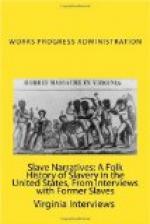Some settled in Madison, Indiana. Two brothers and their families went on to Ohio, and the rest came to Indianapolis.
John Scott, one of their number was a hod carrier. He earned $2.50 a day, knowing that would not accumulate fast enough, he was strong and thrifty. After he had worked hard all day, he would spend his evenings putting new bottoms in chairs, and knitting gloves for anyone who wanted that kind of work. In the summer he made a garden, sold his vegetables. He worked very hard, day and night, and was able to save some money.
He could not read or write, but he taught his children the value of truthfulness, cleanliness of mind and body, loyalty, and thrift. The father and his sons all worked together and bought some ground, built a little house where the family lived many years.
Before old Mr. Scott died, he had saved enough money to give each son $200.00. His bank was tin cans hidden around in his house.
Will Scott, the artist, is a grandson of this John Scott.
The thing these early settlers wanted most, was for their children to learn to read and write. So many of them had been caught trying to learn to write, and had had their thumbs mashed, so they would not be able to hold a pencil.
Interviewer’s Comment
Mrs. Johnson is a very interesting old woman and remembers so well the things her parents told her. She deplores the “loose living,” as she calls it of this generation.
She is very deliberate, but seems very sure of the story of her early life.
Submitted December 9, 1937
Indianapolis, Indiana
Ex-Slave Stories
District No. 5.
Vanderburgh County
Lauana Creel
The story of Betty Jones
429 Oak Street, Evansville, Ind.
From an Interview with Elizabeth Jones at 429 Oak Street, Evansville, Ind.
“Yes Honey, I was a slave, I was born at Henderson, Kentucky and my mother was born there. We belonged to old Mars John Alvis. Our home was on Alvis’s Hill and a long plank walk had been built from the bank of the Ohio river to the Alvis home. We all liked the long plank walk and the big house on top of the hill was a pretty place.”
Betty Jones said her master was a rich man and had made his money by raising and selling slaves. She only recalls two house servants were mulatoes. All the other slaves were black as they could be.
Betty Alvis lived with her parents in a cabin near her master’s home on the hill. She recalls no unkind treatment. “Our only sorrow was when a crowd of our slave friends would be sold off, then the mothers, brothers, sisters, and friends always cried a lot and we children would grieve to see the grief of our parents.”
The mother of Betty was a slave of John Alvis and married a slave of her master. The family lived at the slave quarters and were never parted. “Mother kept us all together until we got set free after the war,” declares Betty. Many of the Alvis negroes decided to make their homes at Henderson, Kentucky. “It was a nice town and work was plentiful.”




